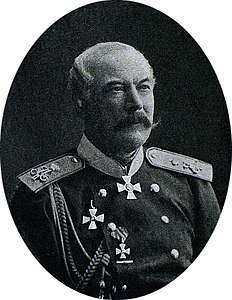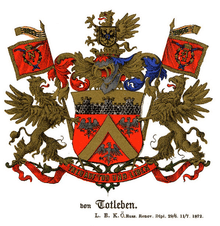Eduard Totleben
Franz Eduard Graf[lower-alpha 1] von Tottleben[lower-alpha 2] (Russian: Эдуа́рд Ива́нович Тотле́бен, tr. Eduárd Ivánovich Totlében; 20 May [O.S. 8 May] 1818 – 1 July [O.S. 19 June] 1884), better known as Eduard Totleben in English, was a Baltic German military engineer and Imperial Russian Army general.[4] He was in charge of fortification and sapping work during a number of important Russian military campaigns.
Franz Eduard von Tottleben | |
|---|---|
 Eduard Totleben | |
| Born | 20 May 1818 Mitau, Courland Governorate, Russian Empire |
| Died | 1 July 1884 (aged 66) Bad Soden, Grand Duchy of Hesse, German Empire |
| Allegiance | |
| Service/ | Imperial Russian Army |
| Years of service | 1836–1884 |
| Rank | Engineer-General |
| Battles/wars | Caucasian War Crimean War Russo-Turkish War |
| Awards | Order of St. Andrew Order of St. George (2nd class) Order of St. Vladimir Order of the Cross of Takovo[1] Order of Prince Danilo I[2] |
Early life
Totleben was born at Mitau in Courland (now Jelgava, Latvia). His parents were of Thuringian descent and originated in Tottleben, belonging to the Baltic German noble Tottleben family (ru) (also spelled Totleben or Todleben), but had since became merchants. Eduard himself was intended for commerce, but a strong instinct led him to seek a career as a military engineer. He entered the school of engineers at Saint Petersburg, now Military engineering-technical university (Russian: Военный Инженерно-Технический университет).
Military career
Early military career
Totleben joined the Imperial Russian Army in 1836. He saw active service as captain of engineers in the campaigns against Imam Shamil in the Caucasus, beginning in 1848 for two years.[4]
Crimean War
At the outbreak of war between Russia and the Ottoman Empire in 1853, he took part in the siege of Silistria, and after the siege was raised was transferred to the Crimea. Sevastopol, while strongly fortified toward the sea, was almost unprotected on the land side. Totleben, though still a junior field officer, became the animating genius of the defense. On his advice the fleet was sunk, in order to block the mouth of the harbour, and the deficiency of fortifications on the land side was made good before the allies could take advantage of it. The construction of earthworks and redoubts was carried out in extreme haste and much of the artillery from the warships was transferred to them. It was in the ceaseless improvisation of the defensive works and offensive counterworks to meet every changing phase of the enemy's attack that Totleben's peculiar strength and originality showed itself. He never commanded a large army in the open field, nor was he the creator of a great permanent system of defence like Vauban. But he may justly be called the originator of the idea that a fortress should be considered not a walled town but an entrenched position, intimately connected with the offensive and defensive capacities of an army and as susceptible of alteration as the formation of troops in battle or manoeuvre.[4]
Until 20 June 1855, Totleben conducted operations for the defense at Sevastopol in person; he was then wounded in the foot and was not present at the operations which immediately preceded the fall of the fortress. In the course of the siege he had risen from the rank of lieutenant-colonel to that of lieutenant-general, and had also been made aide-de-camp to the tsar. When he recovered he was employed in strengthening the fortifications at the mouth of the Dnieper, and also those of Kronstadt.[4] In 1864, he suggested further improvements of the Brest Fortress that were implemented between then and 1868.[5][6] In 1856 he visited England, where his merits were honoured.
On 24 March 1854, the Russian novelist Fyodor Dostoyevsky wrote him a letter asking for his help in returning to European Russia - the writer had been sentenced to four years of banishment in Siberia. (Totleben's brother Adolf had been Dostoyevsky's classmate at the school of military engineering in Saint Petersburg.)
Russo-Turkish War, 1877–78
In 1860 Totleben was appointed assistant to Grand Duke Nicholas, and he subsequently became head of the department of engineers with the full rank of general. He received no command when another war against the Ottoman Empire began in 1877.[7] Only after the early Russian reverses before Plevna was the hero of Sevastopol called to the front. Totleben saw that it would be necessary to draw engineering works around Osman Pasha and cut him off from communication with the other Turkish commanders. In due time, Plevna fell. Totleben then undertook the siege of the Bulgarian fortresses. After the conclusion of the preliminaries of peace, he was placed in command of the whole Russian army.[4][7]
Later life
After the war Totleben was assigned to be Governor General of Bessarabia and Novorossiya.[8] He also became a hereditary Count.
In 1880, Totleben held the post of Governor General of Vilna, and after much suffering he died at Bad Soden near Frankfurt am Main. He is buried in Sevastopol.
The village of Totleben in Pordim Municipality, Pleven Province, is named after Eduard Totleben, in honour of his decisive role in the Siege of Plevna of 1877.
Notes
References
- Acović, Dragomir (2012). Slava i čast: Odlikovanja među Srbima, Srbi među odlikovanjima. Belgrade: Službeni Glasnik. p. 621.CS1 maint: ref=harv (link)
- Acović, Dragomir (2012). Slava i čast: Odlikovanja među Srbima, Srbi među odlikovanjima. Belgrade: Službeni Glasnik. p. 621.CS1 maint: ref=harv (link)
- Klingspor, Carl Arvid. Baltic coat of arms book, pp. 117
- Chisholm 1911.
- Бешанов В.В. ”Бресткая крепость” Минск, 2004 (in Russian) ISBN 985-01-0428-7
- Суворов А.М. “Брестская крепость на ветрах истории”, Brest, 2004 (text in Russian) ISBN 985-90040-1-3
- Greene, F. V. (1881). "Russian Generals". Sketches of Army Life in Russia. London: W.H. Allen & Co. pp. 147–148. Retrieved July 26, 2018 – via Internet Archive.
- Herlihy, Patricia (1991) [1987]. Odessa: A History, 1794-1914. Cambridge, MA: Harvard University Press. ISBN 0-916458-15-6. ISBN 0-916458-43-1, paperback reprint. p. 158

